Humboldt Penguin
Spheniscus humboldti
Found on the South American coast!
Advertisement
Humboldt Penguin Scientific Classification
- Kingdom
- Animalia
- Phylum
- Chordata
- Class
- Aves
- Order
- Sphenisciformes
- Family
- Spheniscidae
- Genus
- Spheniscus
- Scientific Name
- Spheniscus humboldti
Read our Complete Guide to Classification of Animals.
Humboldt Penguin Conservation Status
Humboldt Penguin Facts
- Main Prey
- Krill, Fish, Shrimp
- Distinctive Feature
- Pink base of beak and black and white markings
- Habitat
- Rocky Ocean Islands
- Predators
- Leopard Seal, Killer Whale, Sharks
- Diet
- Carnivore
- Average Litter Size
- 2
- Lifestyle
- Colony
- Favorite Food
- Krill
- Type
- Bird
- Slogan
- Found on the South American coast!
View all of the Humboldt Penguin images!
“Humboldt Penguins are piscivores!”
Capable of swimming up to 30 miles an hour, the Humboldt penguin is a very interesting bird. These penguins have a distinct black-and-white appearance with a black breast band. They live along the west coast of Chile and Peru near the Humboldt Current, for which they were named. Humboldt penguins are piscivores, a type of carnivore that eats fish.
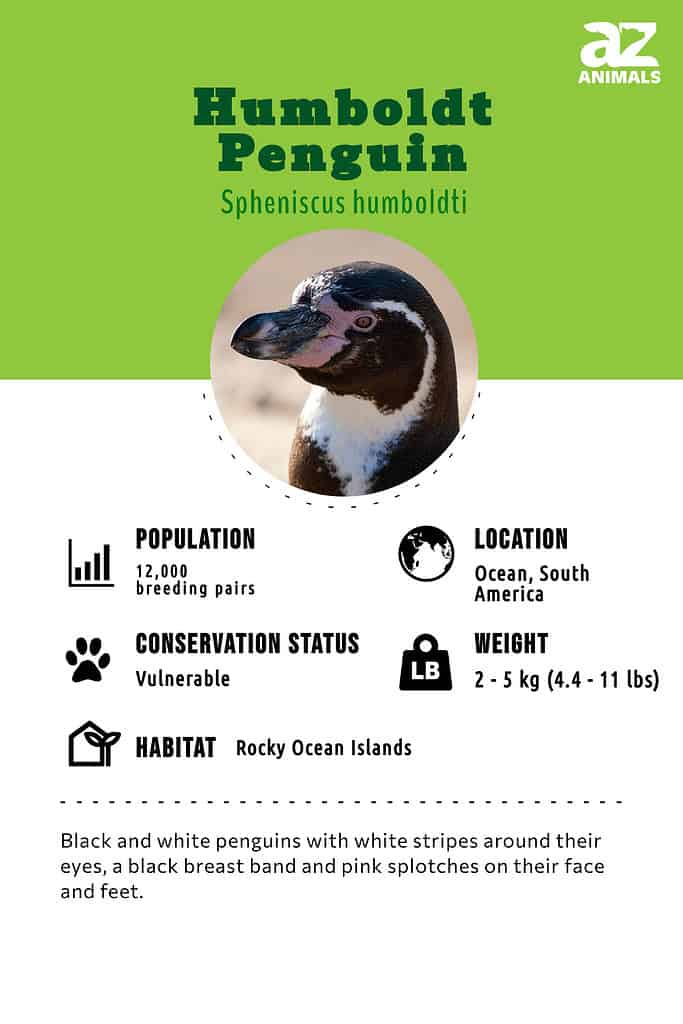
Incredible Humboldt Penguin Facts!
- Humboldt penguin chicks have brown feathers instead of the black feathers adults have.
- Unlike other birds that only use their feet as paddles, these penguins also use their feet to help them steer.
- Humboldt penguins have developed different calls to communicate. For example, they have a yell warning call if they feel threatened and a bray call to attract a mate.
- These penguins nest in guano, which is layers of bird poop.
- The oldest Humboldt penguin lived to be 36 years old.

Humboldt penguins are popular in zoos all over the world, including The Moskavrium, or Moscow Aquarium.
©art nick/Shutterstock.com
Scientific name
The scientific name for the bird is Spheniscus humboldti. Spheniscus is derived from the Greek word, sphēniskos, meaning small wedge. This word refers to the shape of a penguin’s body. Humboldti refers to Alexander Van Humboldt who was a German naturalist and explorer. The sea current where the penguins live on South America’s west coast was named after Alexander Von Humboldt.
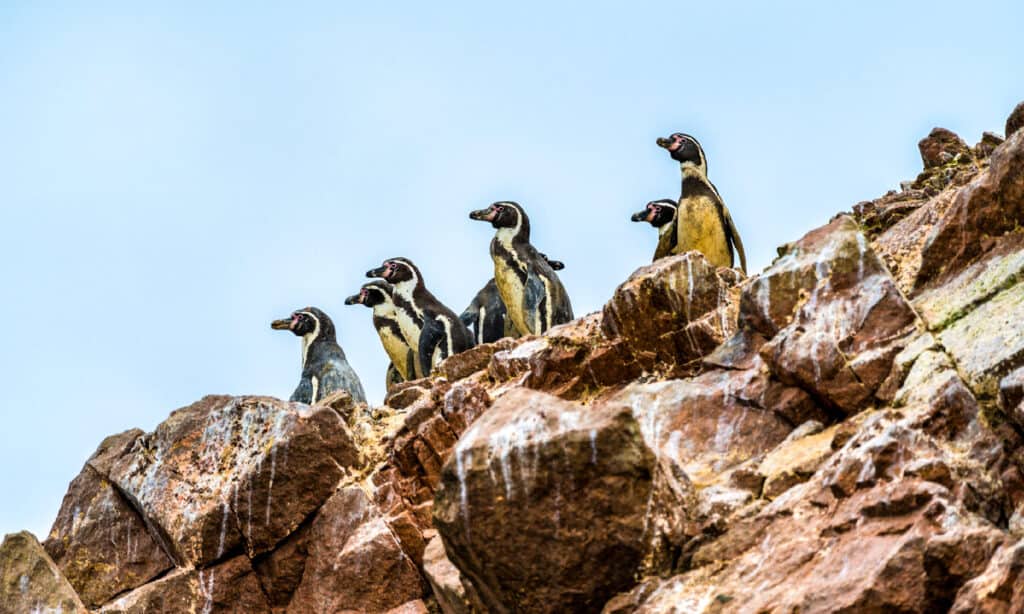
Humboldt penguins live on the west coast of South America.
©iStock.com/Leonid Andronov
Evolution
Fossil records indicate that Humboldt penguins’ common ancestors lived as long as 40 million years ago and were around five feet tall. They are believed to have originated in Antarctica, which was covered in forests at that time and connected to what would become New Zealand, Australia, South America, and surrounding islands. These ancient ancestors of penguins had diverged from the ancestors of petrels and albatrosses around 71 million years ago.
The arrival of the ice age 35 million years ago brought brutal changes to the ancient ancestors of the penguin. The continents of Australia and South America drifted away from Antarctica while ocean currents encircled it. This cooling climate likely killed the older penguins – leaving them to compete with whales for the same prey.
While most of the ancient penguins became extinct, others, like the Humboldt penguin, swam to warmer waters to found new lineages. Species like the emperor penguin stayed in Antarctica and evolved adaptations suited to live in the cold environment.
Appearance and Behavior
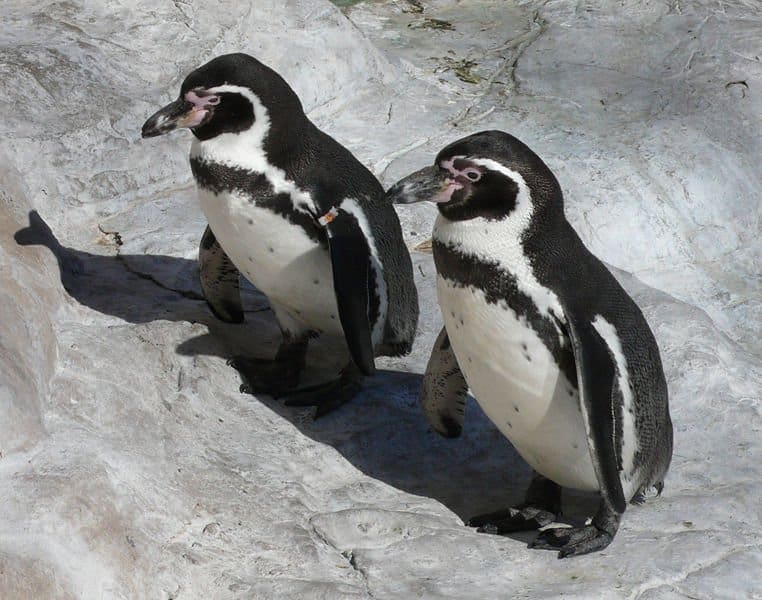
Humbolt Penguins, like all penguins, have a thick layer of fat to keep them warm.
Like other penguins, they are black and white. This is one of the adaptations that help penguins camouflage and stay protected from their predators. Their heads have a white stripe that goes sideways from above their eye to around their ear. The stripes from both sides of their head meet at their throat. Adult birds have a black breast band with a white belly. They also have splotches of pink on their feet, face, and beneath their wings.
These penguins also have three layers of overlapping short feathers and a thick layer of fat that work together to keep them dry and warm. These are other adaptations that have helped the Humboldt penguins to survive in their habitat.
Young penguins differ in appearance from their adult counterparts in that they are brown instead of black and do not have a breast band. The Magellanic Penguin is very similar in appearance to these birds, but they have two black breast bands instead of just one.
The adult penguins are about 28 inches long and weigh about 9 pounds, just less than the average weight of a domestic cat. The female penguins are typically a little smaller than their male counterparts.
Humboldt penguins are very social and prefer to be with others. They live in small groups known as rookeries.

Humboldt penguins live in groups called rookeries.
©Liam Gutierrez Huamani/Shutterstock.com
Habitat
Humboldt penguins live in the coastal areas of Peru and Chile. They can be found on rocky shores or on the islands in the area. Since they feed on fish in the Humboldt Current, they choose areas to live that are near this current.
Diet
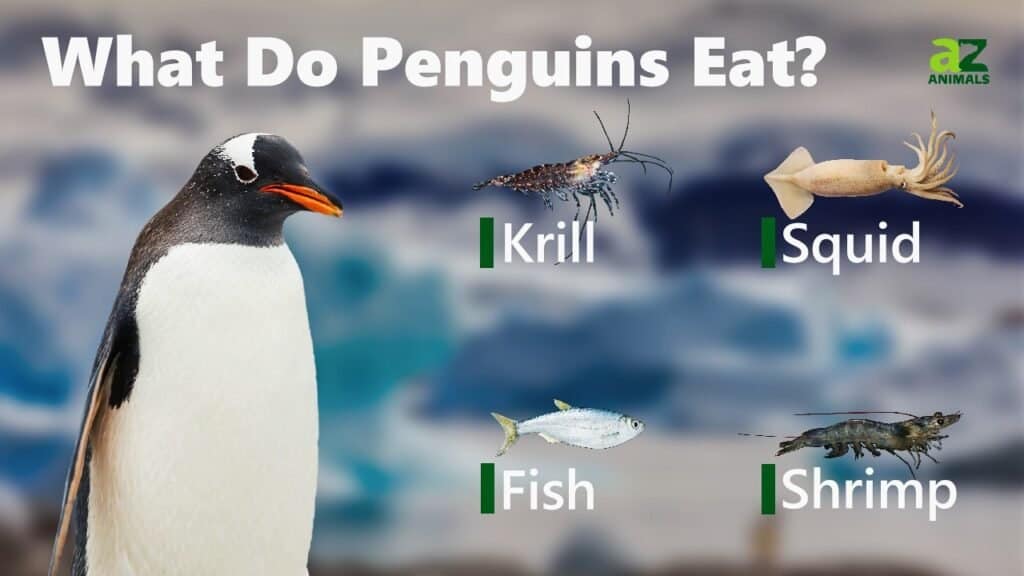
The food of choice for a Humboldt Penguin is anchoveta, a small fish. In addition to anchoveta, they also eat sardines, krill, and squid.
Predators and Threats
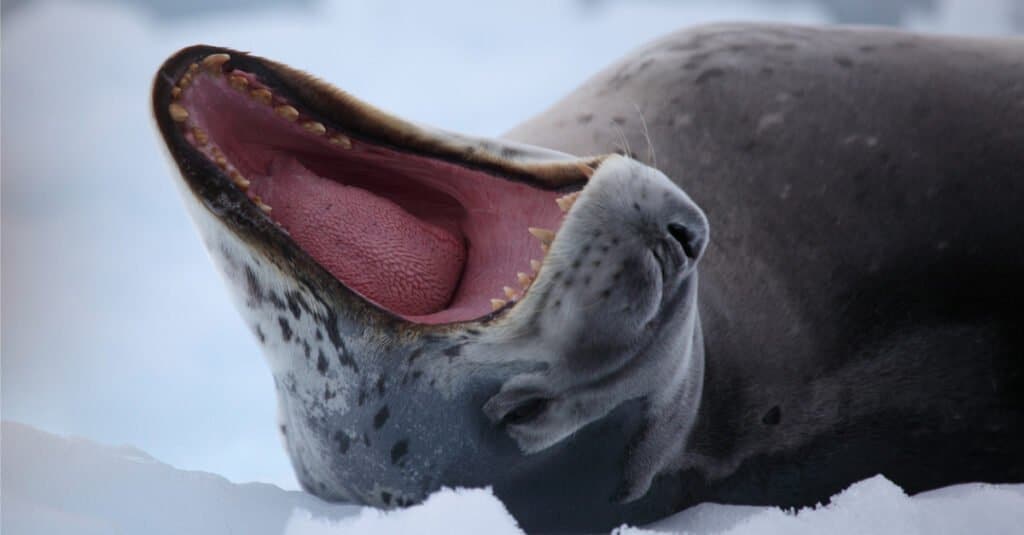
Leopard
seals prey on Humboldt penguins.
©iStock.com/MogensTrolle
Unfortunately, these penguins face many predators and threats. They are a favorite food of sea lions, leopard seals, fur seals, killer whales, and great white sharks. Humboldt penguin eggs are often eaten by snakes, foxes, and birds.
In addition to predators in nature, humans also pose a threat to these penguins. Commercial fisherman fish in the areas where the penguins live, which reduces the number of fish that are available for the penguins. Humboldt penguins also die when they get tangled up in the fishing nets the fishermen use. Humans also threaten their habitat when they harvest guano deposits to use for fertilizer. These penguins choose to nest in the guano deposits, so as the resources are depleted, fewer areas are available for them to nest.
Climate change also threatens these birds. Rising temperatures in the Arctic have started to decrease the amount of fish available in the Humboldt Current.
Because of all the threats that Humboldt penguins face, they face a risk of extinction. Their current conservation status is vulnerable.
Reproduction, Babies, and Lifespan
Humboldt penguins find a lifelong mate, like other penguins. These penguins bow their head and use alternating eyes to exchange glances with penguins of the opposite sex during courtship. They stretch their heads up, flap their wings, and let out a loud call to try to attract a partner.
The male and female penguins work together to dig their burrow in dried bird poop called guano. Each female lays two eggs at a time. The peak months for laying eggs are April through August. The eggs take about 40 days to incubate. During the incubation period, both the male and female penguins take turns sitting on the eggs.
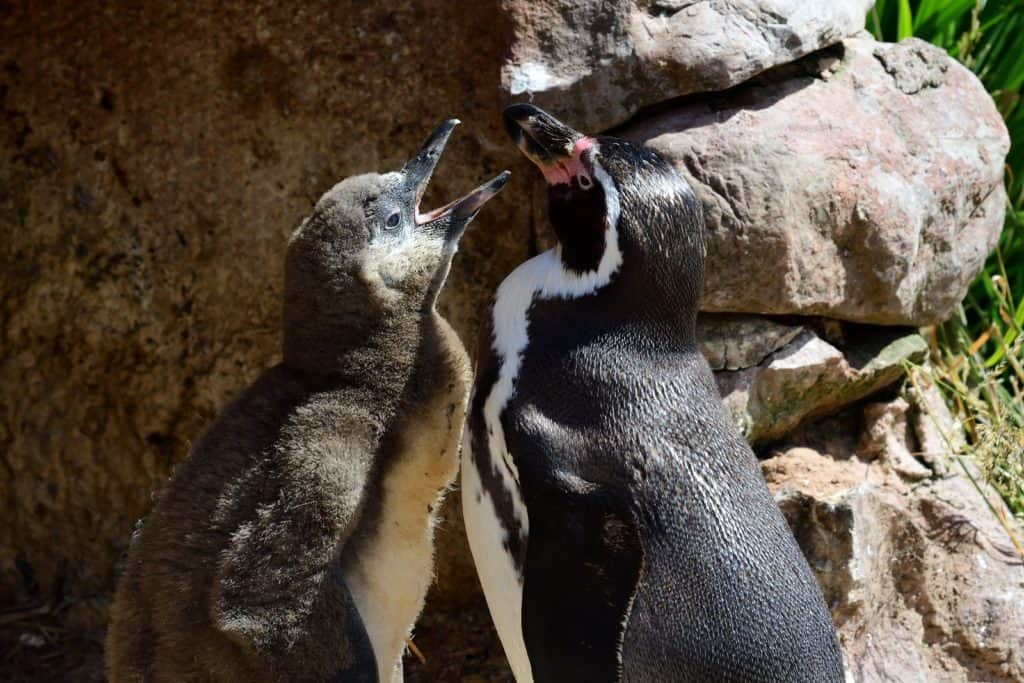
Humboldt penguins mate for life and raise their chicks together.
©Tom Meaker/Shutterstock.com
When baby penguins are born, they have grayish-brown feathers. At around the age of 70 to 90 days, the baby penguins will molt. At this time, their brown baby feathers are replaced with gray adult feathers. However, the young penguins still will not get their black breast band until they become an adult.
Until they have their adult feathers, the penguin chicks are unable to maintain their body temperature. They need to stay in their nest to keep warm, and their parents feed them by regurgitating food. One parent will stay with the chicks at the nest to keep them safe. After the chicks molt and get their adult feathers, they are able to leave the nest and begin looking for their own food.
Once Humboldt penguins are two years old, they are considered an adult. At this time, they return to the rookery to look for a mate.
The lifespan for most Humboldt penguins is about 20 years. Although, some of these penguins in captivity can live as long as 30 years. The oldest one lived to be 36. Her name was Emmanuelle, and she lived at the Akron Zoo in Ohio.
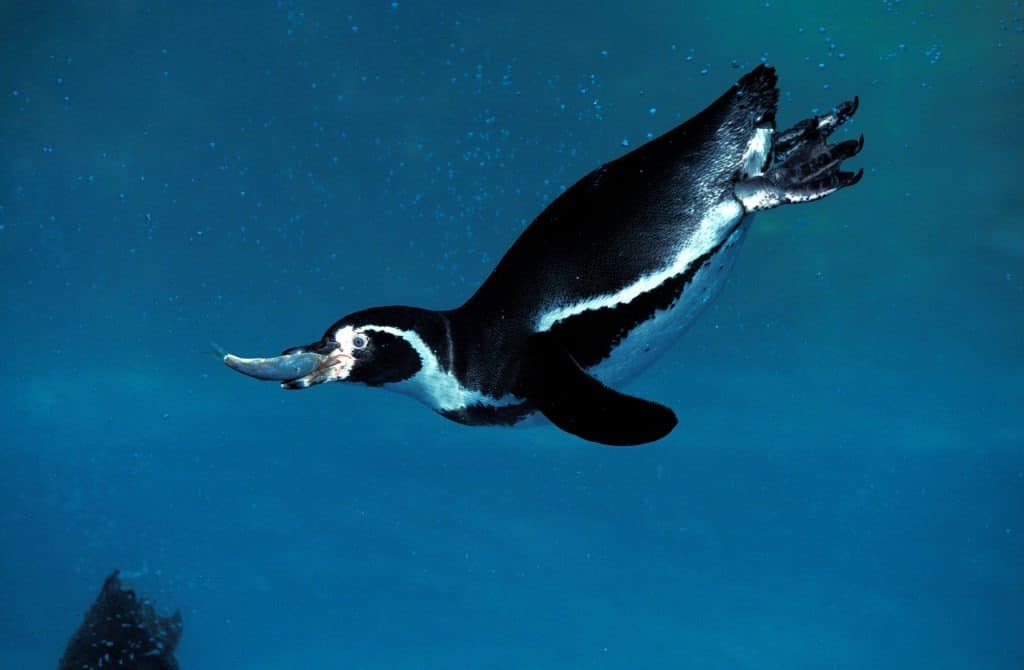
Humboldt penguins have been given a vulnerable conservation status.
©slowmotiongli/Shutterstock.com
Population
Currently, there are only about 12,000 breeding pairs of Humboldt penguins left. About 4,000 pairs are located in Peru, and about 8,000 pairs are located in Chile. This penguin population is declining due to the threats they face from humans and predators in nature. These penguins have been given a vulnerable conservation status due to their declining population.
In the Zoo

The Oregon Zoo features Humboldt penguins.
©Michael Gordon/Shutterstock.com
If you want to see these penguins in person, there are many zoos in the United States where you can do so. Some of these include the Saint Louis Zoo, Denver Zoo, Oregon Zoo, Akron Zoo, and Philadelphia Zoo
Humboldt Penguin FAQs (Frequently Asked Questions)
Are Humboldt penguins carnivores, herbivores, or omnivores?
These penguins are carnivores, or piscivores since they eat fish.
How long do Humboldt penguins live?
In the wild, most Humboldt penguins live to be somewhere between 15 and 20 years old. In captivity, they can live longer and may reach closer to 30 years old. The oldest known Humboldt penguin lived to be 36 years old.
What does the Humboldt penguin eat?
Humboldt penguins eat anchoveta, a type of fish sardines, squid, and crustaceans, like krill.
How tall is the Humboldt penguin?
The average height of a Humboldt penguin is 28 inches.
Why is the Humboldt penguin endangered?
There are a number of reasons the Humboldt penguin is endangered. Human fish in the current where the Humboldt penguins eat, which means there are fewer fish available for them to catch. Additionally, some Humboldt penguins become tangled up in the nets cast by the fishermen, which kills them.
Climate change is also threatening Humboldt penguins. The warmer water coming up the from the arctic is causing the number of fish to decrease, making it even harder for Humboldt penguins to find food.
In addition to these threats, Humboldt penguins are also eaten by predators like great white sharks, killer whales, sea lions, and leopard seals.
How did the Humboldt penguin get its name?
The Humboldt penguin was named after the Humboldt current where they swim and catch their food. The Humboldt current is a cold current that runs from Chile to Peru along South America’s west coast. The current was named after Alexander von Humboldt, an explorer.
How many Humboldt penguins are left in the world?
There are about 12,000 breeding pairs of Humboldt penguins left in the world. About 8,000 of these pairs are located in Chile and about 4,000 are in Peru.
How fast can a Humboldt penguin swim?
Humboldt penguins use their wings to help them swim underwater. They are capable of reaching speeds up to 30 miles per hour.
How deep can Humboldt penguins dive?
Humboldt penguins can dive up to 30 meters deep. People have even recorded them diving as deep as 53 meters.
What Kingdom do Humboldt Penguins belong to?
Humboldt Penguins belong to the Kingdom Animalia.
What phylum do Humboldt Penguins belong to?
Humboldt Penguins belong to the phylum Chordata.
What class do Humboldt Penguins belong to?
Humboldt Penguins belong to the class Aves.
What family do Humboldt Penguins belong to?
Humboldt Penguins belong to the family Spheniscidae.
What order do Humboldt Penguins belong to?
Humboldt Penguins belong to the order Sphenisciformes.
What genus do Humboldt Penguins belong to?
Humboldt Penguins belong to the genus Spheniscus.
What type of covering do Humboldt Penguins have?
Humboldt Penguins are covered in Feathers.
In what type of habitat do Humboldt Penguins live?
Humboldt Penguins live in rocky ocean islands.
What are some predators of Humboldt Penguins?
Predators of Humboldt Penguins include leopard seals, killer whales, and sharks.
What are some distinguishing features of Humboldt Penguins?
Humboldt Penguins have beaks with a pink base and black and white markings.
How many babies do Humboldt Penguins have?
The average number of babies a Humboldt Penguin has is 2.
What is an interesting fact about Humboldt Penguins?
Humboldt Penguins are found on the South American coast!
What is the scientific name for the Humboldt Penguin?
The scientific name for the Humboldt Penguin is Spheniscus humboldti.
How do Humboldt Penguins have babies?
Humboldt Penguins lay eggs.
Thank you for reading! Have some feedback for us? Contact the AZ Animals editorial team.
Sources
- David Burnie, Dorling Kindersley (2011) Animal, The Definitive Visual Guide To The World's Wildlife
- Tom Jackson, Lorenz Books (2007) The World Encyclopedia Of Animals
- David Burnie, Kingfisher (2011) The Kingfisher Animal Encyclopedia
- Richard Mackay, University of California Press (2009) The Atlas Of Endangered Species
- David Burnie, Dorling Kindersley (2008) Illustrated Encyclopedia Of Animals
- Dorling Kindersley (2006) Dorling Kindersley Encyclopedia Of Animals
- Christopher Perrins, Oxford University Press (2009) The Encyclopedia Of Birds
- Peru Aves, Available here: http://www.peruaves.org/spheniscidae/humboldt-penguin-spheniscus-humboldti/#:~:text=Meaning%20of%20Name%3A%20Spheniscus%3A%20Gr,more%20of%20the%20Family%20Spheniscidae
- Saint Louis Zoo, Available here: https://www.stlzoo.org/animals/abouttheanimals/birds/penguins/humboldtpenguin
- Centre for Biological Diversity, Available here: https://www.biologicaldiversity.org/species/birds/penguins/Humboldt_penguin.html#:~:text=HABITAT%3A%20This%20penguin%20nests%20on,krill%20and%20fosters%20fish%20abundance.
- Wikipedia, Available here: https://en.wikipedia.org/wiki/Humboldt_penguin
- Organization for the Conservation of Penguins, Available here: http://www.penguins.cl/humboldt-penguins.htm#:~:text=The%20total%20world%20population%20of,remaining%204%2C000%20pairs%20in%20Peru.
- ANIMALIA, Available here: http://animalia.bio/humboldt-penguin#:~:text=Humboldt%20penguins%20are%20carnivores%20(piscivores,penguins%20primarily%20consists%20of%20fish.

















